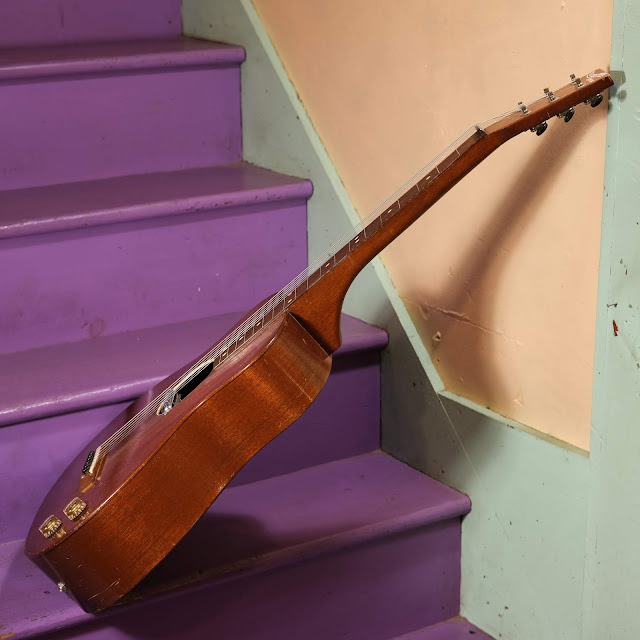1930s Gibson-made Mastertone Special Hawaiian Guitar (Electrified)
Update 2019: This guitar is now in for sale and so I took new photos and recorded a couple of video clips. I've updated this post with those and also added a little more commentary.
Gibson made these Mastertone Specials as student Hawaiian guitars ("square" necks and strings set above the neck for slide/lap play) in the mid-30s and they share the body shape and ladder bracing of the more-often-seen KG-11 models, though they're entirely made from solid mahogany, have a 12-fret (bolted!) neck joint, and rosewood board with painted frets.
Gibson made these Mastertone Specials as student Hawaiian guitars ("square" necks and strings set above the neck for slide/lap play) in the mid-30s and they share the body shape and ladder bracing of the more-often-seen KG-11 models, though they're entirely made from solid mahogany, have a 12-fret (bolted!) neck joint, and rosewood board with painted frets.
They're not well-received guitars in the vintage market (well, what Hawaiian guitar is?), but I honestly think they sound awfully good for a mid-grade Hawaiian flattop from the time -- they have that sing-songy, woody, sweet, mahogany tone and the bridge is exactly in the best place for driving the top.
A friend of mine has been playing this for a long time and I helped him replace a bad saddle and shore-up some of the old repairs to it last year, but in 2017 he called me up asking if I could electrify it for him. As that sort of thing is right up my alley, I said, "of course!"
Work included: a hot Dano-style Alnico-magnet lipstick pickup (8k ohms vs 3-4k on the originals) installed at the soundhole and installation of a tone+vol wiring harness. I also replaced the saddle with a new bone one and grounded the strings with a copper shielding-tape addition at the bridge plate. I also finally had the excuse to shore-up some damage the guitar had sustained over time. In that regard, I sealed and cleated various cracks on the top and back, added a "popsicle-brace" under the fretboard extension, cleanted it up a bit, and made sure it was stable and good to go.
Work included: a hot Dano-style Alnico-magnet lipstick pickup (8k ohms vs 3-4k on the originals) installed at the soundhole and installation of a tone+vol wiring harness. I also replaced the saddle with a new bone one and grounded the strings with a copper shielding-tape addition at the bridge plate. I also finally had the excuse to shore-up some damage the guitar had sustained over time. In that regard, I sealed and cleated various cracks on the top and back, added a "popsicle-brace" under the fretboard extension, cleanted it up a bit, and made sure it was stable and good to go.
Scale length: 24 3/4"
Nut width: 1 15/16"
String spacing at nut: 1 5/8"
String spacing at bridge: 2 3/8"
Body length: 17 3/8"
Lower bout width: 14 3/4"
Upper bout width: 10"
Side depth at endpin: 4 1/8"
Top wood: solid mahogany
Back/sides wood: solid mahogany
Bracing type: ladder-braced
Fretboard: rosewood
Bridge: unknown wood
Neck feel: medium rectangular shape, flat board
Condition notes: there are multiple repaired hairline cracks on the top and back (including a few at the fretboard extension on top), the bridge was sloppily (but functionally) reglued in the past, and the bridge pins, pickup, and wiring harness are all non-original. While the finish shows plenty of mild wear throughout, it looks pretty nice overall and has a pretty, warm-nut-brown natural color to it.
It comes with: an old, non-original chip case.
The guitar is much-abused, but the new pickup and knobs give it a bit of a "dapper dandy" look, now. It also doesn't hurt that the mahogany on this instrument looks so darn good!
Like anything Gibson-made, even this "student model" was a good-quality, well-thought-out product when made.
I used a Strat-sized modern lipstick pickup but mounted it to a Danelectro-width brass baseplate from my parts-bins so that I could get the mounting holes where I wanted them.
The upper part of the soundhole shows a crunch-in slip of the fretboard-extension bit of the top vs. the rest of the top. That's been dealt-with as-regards creeping via brace reglues and the installation of a popsicle-style brace under the top in the same location.
The upper part of the soundhole shows a crunch-in slip of the fretboard-extension bit of the top vs. the rest of the top. That's been dealt-with as-regards creeping via brace reglues and the installation of a popsicle-style brace under the top in the same location.
The new saddle is 100% boring, but works just-fine. Note the original bridge bolts! Save time, save a dime, right?
It's hard to see them, but there are three long-ish repaired hairline cracks on the back.
The original, open-backed Kluson tuners work just fine.
The "33" on the heel appears to be meaningless to modern Gibson-info resources. The usual Factory Order Number is also not available, so a specific year of manufacture can't be determined. I imagine it was made in the mid-1930s, though.

















Comments